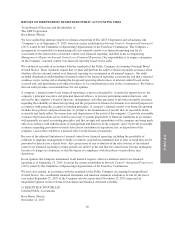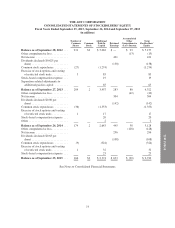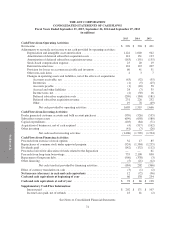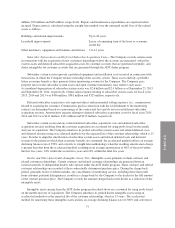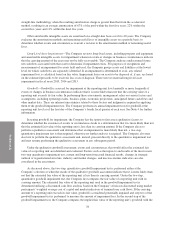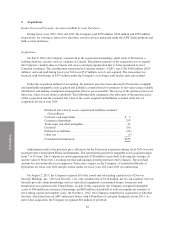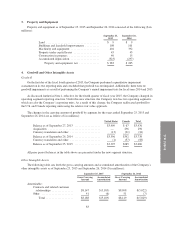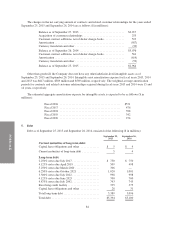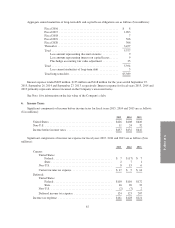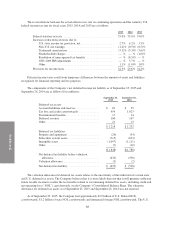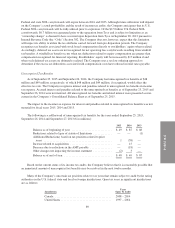ADT 2015 Annual Report Download - page 153
Download and view the complete annual report
Please find page 153 of the 2015 ADT annual report below. You can navigate through the pages in the report by either clicking on the pages listed below, or by using the keyword search tool below to find specific information within the annual report.
FORM 10-K
carrying amount of the reporting unit’s goodwill. If the carrying amount of the reporting unit’s goodwill exceeds
the implied fair value of that goodwill, an impairment loss is recognized in an amount equal to the excess of the
carrying amount of goodwill over its implied fair value. The implied fair value of goodwill is determined in the
same manner that the amount of goodwill recognized in a business combination is determined. The fair value of
the reporting unit is then allocated to all of the assets and liabilities of that unit, including intangible assets, as if
the reporting unit had been acquired in a business combination. Any excess of the fair value of the reporting unit
over the amounts assigned to its assets and liabilities represents the implied fair value of goodwill.
Accrued Expenses and Other Current Liabilities—Accrued and other current liabilities as of September 25,
2015 and September 26, 2014 consisted of the following ($ in millions):
September 25,
2015
September 26,
2014
Payroll-related accruals ...................... $ 79 $ 45
Insurance-related accruals .................... 39 38
Accrued interest ............................ 44 44
Accrued dividends .......................... — 35
Other accrued liabilities ...................... 69 98
Total ..................................... $231 $260
Income Taxes—The Company accounts for income taxes under the asset and liability method, which
requires the recognition of deferred tax assets and liabilities for the expected future tax consequences of events
that have been included in the financial statements. The calculation of income taxes for the Company requires a
considerable amount of judgment and use of both estimates and allocations. Prior to the Separation, the Company
primarily operated within a Tyco U.S. consolidated group and within a standalone Canadian entity. In certain
instances, tax losses or credits generated by Tyco’s other businesses continue to be available to the Company in
periods after the Separation.
In determining taxable income for the Company’s Consolidated Financial Statements, the Company must
make certain estimates and judgments. These estimates and judgments affect the calculation of certain tax
liabilities and the determination of the recoverability of certain of the deferred tax assets, which arise from
temporary differences between the tax and financial statement recognition of revenue and expense.
In evaluating the Company’s ability to recover its deferred tax assets, the Company considers all available
positive and negative evidence including its past operating results, the existence of cumulative losses in the most
recent years and its forecast of future taxable income. In estimating future taxable income, the Company
develops assumptions including the amount of future pre-tax operating income, the reversal of temporary
differences and the implementation of feasible and prudent tax planning strategies. These assumptions require
significant judgment about the forecasts of future taxable income and are consistent with the plans and estimates
the Company is using to manage its underlying businesses.
The Company does not have any significant valuation allowances against its net deferred tax assets.
Changes in tax laws and rates could also affect recorded deferred tax assets and liabilities in the future.
Management records the effect of a tax rate or law change on the Company’s deferred tax assets and liabilities in
the period of enactment. Future tax rate or law changes could have a material effect on the Company’s results of
operations, financial condition or cash flows.
In addition, the calculation of the Company’s tax liabilities involves dealing with uncertainties in the
application of complex tax regulations in the United States and Canada. The Company recognizes potential
liabilities and records tax liabilities for anticipated tax audit issues in the U.S. and other tax jurisdictions based on
79


